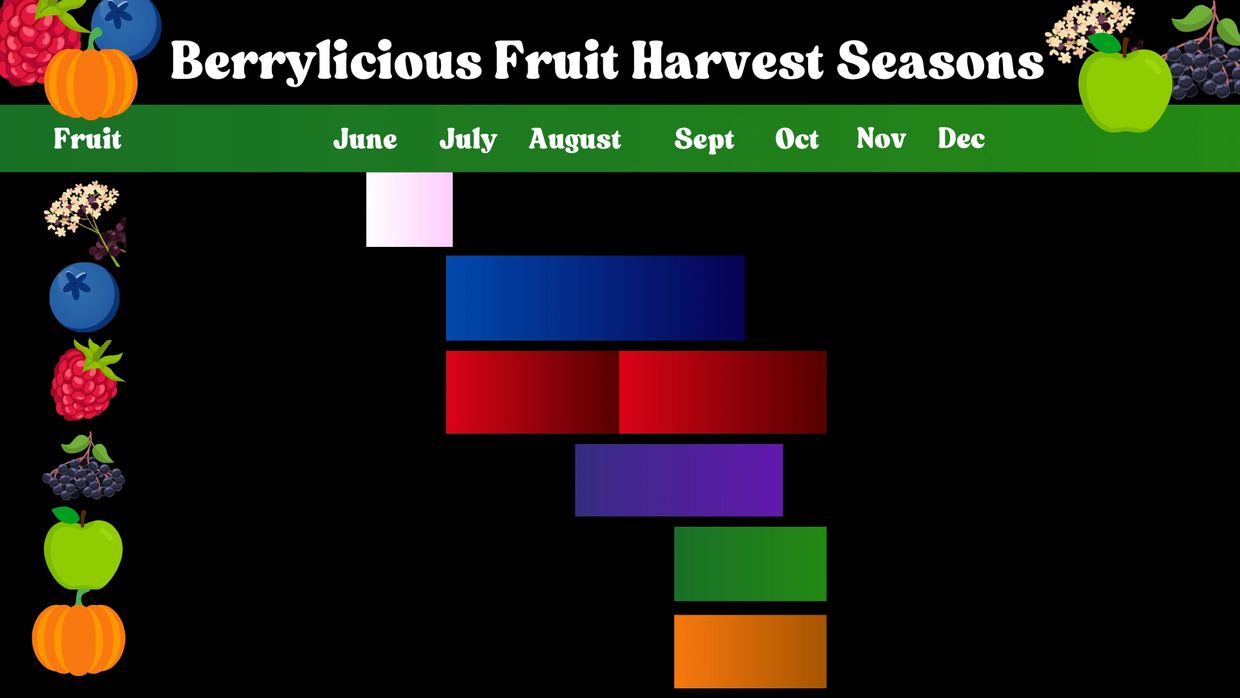Signed in as:
filler@godaddy.com
Signed in as:
filler@godaddy.com

Elderflowers - mid June to Canada Day
Raspberries - late June to mid October
Blueberries - July, August, September
Elderberries - mid August to Labour Day
Apples - September to October
Pumpkins - September to October

April Buds: We usually start to see these blueberry buds swell around mid April. Believe it or not each of these tiny buds is going to burst into 5-10 flowers each. That's a lot of blueberries!
May Flowers: May showers bring us blueberry flower clusters! Every year around the middle of may we start to see our blueberry buds flower a brilliant fuscia colour.
May Bloom: Shortly after they start to form clusters these blossoms will go into full bloom. In a matter of days we see them transform from pink to white.
Pollination: Shout out to our pollinator friends.. berry season wouldn't be possible without them! The bell-like shape of blueberry blossoms and the heavy pollen, doesn't allow for self-pollination. We rent bee hives every year to help cross pollinate.
June Fruit Set: They may look like blueberries..but they sure don't taste like them. Blueberries typically take between 6 weeks and 2 months to ripen after flowering.
July Blueberry Harvest: Typically blueberry harvest begins July 5th - July 10th and it's a 8-10 week season. Our long season is made possible by 8 varieties with different maturity dates.

Blueberries are low in sodium, low in calories and contain no cholesterol, making them the perfect guilt-free snack. Health studies have also proven the power of blueberries to improve memory, lower blood pressure, and reduce the risk of a heart attack. In fact, the pectin found in blueberries actually has the ability to reduce blood cholesterol.
In addition to this, their dark blue skin is pigmented by anthocyanin making them an abundant source of cancer-fighting antioxidants.
Incorporating fresh blueberries into your diet is a great way to get a daily dose of essential vitamins and nutrients, such as Vitamin A, C, K and E!

Fresh, frozen, or baked — blueberries are endlessly versatile:

Each year we follow a pattern of cultivation, beginning with pruning, trellising and ending with harvest.
We have two production styles including field production where raspberry plants are grown in the field. We have summer bearing and everbearing raspberries.
Did you know?
Everbearing raspberries produce two crops: one is harvested in July and the second harvest is in September until frost.
A more recent addition to the farm is the high tech growing system where we plant raspberry canes into pots. The plants are placed under a high tunnel with regular delivery of water and nutrients numerous times a day. This highly intensive production system has numerous benefits including:

Raspberries contain a variety of essential minerals, vitamins, fatty acids, and dietary fibre found in both the skin and seeds. Their unique phytochemical profile (rich in ellagitannins and anthocyanins) set raspberries apart from other rich coloured fruit given their potential to protect against disease.
Studies have shown added benefit in eating fresh, whole raspberries as opposed to phytochemical extracts due to synergistic relationships. Either way we know this sweet treat is completely guilt free, and a perfect snack!
Sweet, tangy, and ready for anything — raspberries shine in every form:

Late May: Elderberries will grow best in moist and loamy soil. If you look closesly you can start to see some buds form.
Early June: By June, these tiny buds have grown tall and sturdy. The little green flower buds have turned into a cluster of white balls that will soon bloom into flowers.
Pollination: Unlike blueberries - Elderberries are mainly pollinated by wind! A Berrylicious, we grow 4 different elderberry varieties. Kent, Essex, Scotia & Victoria.
Late June-July: The balls seem to burst into hundreds of tiny flowers just about as quickly as they appeared.
After pollination, each tiny flower turns into a tiny purple elderberry!
Late July - Early August: Once we see the green berries forming...
The berries are almost ready... and the birds know it too! That’s why we use a “bird cannon” in the late summer months to scare them off.

Elderberries are an excellent source of vitamins A, C and B6. In addition to being very rich in calcium and iron, their dark purple skin is pigmented by anthocyanin making them an abundant source of antioxidants. In fact they’re considered to have one of the highest total antioxidant contents of all small fruits.
Despite rarely being commercially grown and sold in Ontario, elderberries are quickly becoming a well known super-food in the fruit world. It may be time to think about stocking up on some elderberry syrup. A daily dose will provide an immune system boost, plenty of vitamins and minerals, and of course antioxidants!

Tiny but mighty, elderberries are best enjoyed cooked or preserved:
Note: Elderberries must be cooked before eating — raw berries can be toxic!

There is 10 stages of apple fruit buds:
This is our first year of apple harvest with 9 varieties - Click below for harvest dates for your favourite apple variety.

An apple a day keeps the doctor away!
Did you know?
One serving of fruit = one medium sized apple
If you want to know more health benefits - click the link below!

Crisp, juicy, and farm-fresh — apples are the ultimate fall MVP:

Our pumpkin, gourds and squash production serve a dual purpose - they have both an ornamental value and nutritional value.
The best pumpkins for decorating are:

The best pumpkins for cooking:
Health Benefits of Pumpkins:

More than just decor — pumpkins can be both pretty and tasty:
Pro tip: Sugar or pie pumpkins are best for cooking — save the big guys for carving!
We use cookies to analyze website traffic and optimize your website experience. By accepting our use of cookies, your data will be aggregated with all other user data.